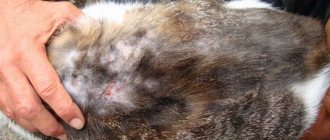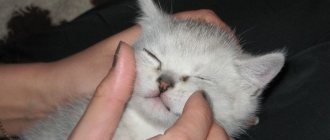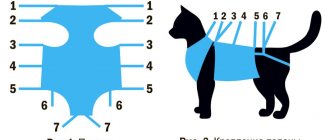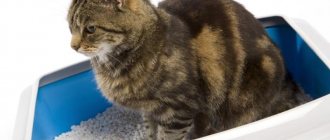Factor 2
Times of Day
The average temperature of cats is related to their sleep and wake patterns. If the animal is sleeping, all processes slow down. Therefore, it is useless to measure the temperature. For some cats, it drops immediately by 1 - 2 degrees from their basic norm. Although, running your hand over the body, the difference is almost not felt.
If you measure the temperature during the day, permissible fluctuations vary within half a degree: this is typical for healthy and active cats. Especially if you find your pet actively playing with his favorite toy.
Morning measurements will be lower than evening ones. In this, the cat is similar to humans and many other warm-blooded animals.
Factor 3
Features of the body
According to the observation of veterinarians, a cat’s body temperature is affected by its eating habits, mood and sensitivity to heat.
If your cat frequently overeats or spends time in a hot environment, its temperature may rise. In addition, minor fluctuations are allowed after experiencing stress. For example, after a trip to the veterinarian, physical punishment, or the owner’s departure.
The period of pregnancy and childbirth also affects a cat’s temperature. Typically, cats' body temperature drops one degree one to two days before kittens are born. Therefore, there is no need to be afraid of this. The main thing is that the “nest” in which the cat gives birth is insulated in advance. A newborn kitten's temperature is very low. This is due to poor thermoregulation processes. Therefore, the female does not even lick some kittens, and the owner has to rub the newborn cub.
As for the length of the coat, it does not depend on body temperature. Contrary to popular belief, Sphynxes and other short-haired breeds maintain the same temperature as long-haired ones: the opinion that the body of a hairless cat seems hot is associated only with the subjective sensations of a person.
How to measure a cat's temperature
A cat’s body temperature is one of the most important objective indicators that determines its overall health. A deviation in a cat’s temperature from the norm, just like in a person, is a very serious symptom, which gives reason to suspect the development of one or another pathological condition in the animal. Most cat owners mistakenly believe that there is no better way to measure a cat’s temperature at home than to assess the condition of the pet’s nose, focusing on whether it is dry or wet, warm or cold. Such actions have nothing to do with determining the animal’s body temperature. That is why every attentive cat owner should be able to independently and, most importantly, correctly measure the temperature of their pet in order to promptly suspect the occurrence of a disease in the animal and contact a veterinarian.
Method for measuring temperature without a thermometer
The nose is an indicator of the health of almost all pets. If it is dry and hot, it means your pet has a fever. But such a conclusion can only be made if the animal is at rest, during active play; such a measurement will definitely not be correct.
Chills at normal room temperatures may indicate illness to the cat's owner. In addition, an elevated temperature can be determined by the animal’s inappropriate behavior, refusal of food and water, or adopting a tense posture.
Of course, all of the above detection methods may be inaccurate, but you should not ignore the strange behavior of your cat.
If you suspect an elevated temperature, it is better to take your pet to a specialist. He will be able to thoroughly examine the animal’s condition, measure the temperature and provide assistance. If your cat is sick, stop by our veterinary pharmacy . We have medicines for various ailments.
Table of normal temperatures for cats
Lower limit/Upper limit
- Normal temperature in adult cats is 37.7 C/39.4 C
- Normal temperature in newborn kittens is 34.7C/37.2C
- Normal temperature for kittens older than 10 days is 36.5 C/37.0 C
- Acceptable limits of normal temperature in cats are 37.50 C/39.50 C
- Unacceptable temperature values in adult cats are below 37.0 C/above 40.5 C
A cause for concern is critical or unacceptable temperature readings, which indicate the development of a pathological process in the animal’s body that requires immediate treatment. A slight increase in temperature or its permissible limits in the absence of any other alarming symptoms is not usually regarded as a manifestation of the disease. Sometimes an increase in temperature values up to 39.5 C is typical for cats that at the time of the examination were in a stressful state, which could arise as a response to the measurement itself. In any case, it is never a bad idea to show the animal to a specialist.
An increase in body temperature in cats is observed during viral infections, bacterial infection, helminthic infestation or inflammatory processes of unknown etiology. Every owner of a furry pet should know how to determine the temperature of a cat, because sometimes this symptom turns out to be the decisive factor in determining the disease in the animal. A reduced body temperature in a cat is characteristic of hypothermia, shock, or the post-anesthesia period. Before determining the temperature of a pregnant cat, it is important to consider that this indicator tends to drop by one degree a few days before giving birth.
Measuring ear canal temperature
The first method is less effective, but easier. To do this, you should buy a special thermometer, which is designed to measure the temperature in the ear of cats. So, determining the cat’s body temperature in the ear canal is as follows :
- press the animal firmly to the floor, it is better if someone helps you with this;
- insert the thermometer, following the instructions specified by the manufacturer;
- measuring the temperature in this way will take about 2 minutes;
- evaluate the result. If the temperature is less than 37.22 and more than 39.17 then contact a specialist.
Methods for determining temperature in cats
Currently, there are only two reliable methods for measuring a cat’s temperature correctly. Veterinarians not only recommend them for use at home, but also use them in their clinics. The first method involves rectal determination of the animal’s temperature using a special electronic thermometer. Naturally, you can use a regular mercury thermometer, but it is worth considering that such a procedure is not the most pleasant for the pet, so the animal will behave very restlessly. An electronic thermometer, unlike a mercury thermometer, has a smaller tip, quickly produces results and does not break, so if necessary, it makes sense to use it.
Before taking your cat's temperature rectally, you should have someone help hold the animal. Then you need to wrap your pet in a towel or put protective gloves on your hands to avoid scratches and bites. The next step is to prepare the thermometer: its tip should be lubricated with cream (vaseline). The thermometer is inserted into the cat's rectum to a depth of 1-1.5 cm and held there until a characteristic sound signal is heard, after which it is carefully and quickly removed. The completion of the procedure is the assessment of the results obtained and their comparison with the norm.
Many cat owners are interested in how to measure a cat’s temperature without rectum. Several years ago, scientists developed a special thermometer that can be used to measure a cat’s temperature through the ear. Today this method is available to everyone. As a rule, most pets react calmly to the insertion of an ear thermometer, so before taking your cat's temperature, it is not at all necessary to ask someone to hold it tightly. While supporting the animal's head, the ear meter should be inserted into the ear canal, wait for the sound alert, and then remove it. Then check the indicators and compare them with the norm.
What measures should be taken if a pet has an elevated body temperature?
After you have measured the cat’s temperature with a regular thermometer, an electronic one, or determined it by external signs, and these indicators turned out to be higher than normal, you should take the animal to a veterinary clinic.
When the temperature rises to 40 °C, you can give the cat Analgin, as well as provide something to drink to avoid dehydration. To do this, they use not only water, but also milk, which the cat will drink with great pleasure.
Attention! In cases where the temperature continues to rise, you can apply ice and a damp towel.
Apply ice wrapped in a towel to your neck and inner thighs. Place a damp sheet on top of the cat and take it to the vet as soon as possible.
If the temperature rises, you can give your cat Analgin
Caring for animals will be rewarded with their tenderness and devotion.
Measurement Rules
It is best if the temperature is measured while the animal is sleeping. If this is not possible, you need to adhere to the following recommendations.
How to give an injection to a cat at the withers: intramuscularly and at home
If possible, you need to wrap the cat in a blanket or a warm blanket so that the paws are fixed and the head and back of the body are free.
To calm the animal, you can scratch it a little behind the ear before the procedure. You need to talk to the animal calmly so that it does not perceive the procedure as a punishment.
It must be taken into account that the cat will resist inserting the thermometer inside even if it seems completely weakened and lifeless. However, these behavioral reactions will be observed only during the first procedure; subsequent ones, as a rule, are calmer.
To obtain a more reliable result, you can determine the animal’s body temperature in different ways (for example, measure it in one way and check it with another). If all the rules are followed and the technique is correct (for example, when inserting a rectal and ear thermometer), the two readings should match.
Note! If you cannot fix the animal yourself, you can contact a veterinary clinic for help and conduct an examination there.
How to measure rectally?
The most accurate and reliable way to measure temperature parameters at home is to use a rectal thermometer. Due to the fact that the process is unpleasant for the animal and causes significant inconvenience, the measurement must be carried out very carefully, and it is best to entrust this matter to a person with experience.
Before taking your cat's temperature, it is recommended to trim its nails. To prevent the pet from resisting, it is better to wrap it in a blanket or hold it by the paws and head. In this case, at least two people will be needed to take the measurement. If the cat behaves calmly, just pet it, then you can begin the procedure. At this moment, the animal should lie on its side or stand. In the first case, the cat should not be allowed to tuck its tail and curl up into a ball.
- Not a thermometer, just not there...
Before starting the measurement, the thermometer must be disinfected, lubricated with a rich cream and carefully inserted into the anus with rotational movements to a depth of 2-3 cm. After the measurement is completed, the cat should be petted and treated with a treat, the thermometer must be treated with a disinfectant.
The accuracy of the readings is achieved by the fact that the sensor is located at the very tip of the thermometer. For the same reason, there is no need to run the device deep. The small size of the thermometer eliminates unnecessary inconvenience, thereby simplifying the measuring process. In addition, the device is equipped with a sensor that signals the end of the procedure.
When not to worry
There are several factors that can cause an increase/decrease in temperature. So, the body warms up by a few tenths of a degree in the late afternoon, after eating and taking certain medications, playing active games, or spending a long time in the sun. A drop in temperature occurs in a pregnant cat a couple of days before giving birth.
If you notice changes in the behavior of the animal, for example, he has become less active, sleeps a lot, refuses to eat, preferring to drink, tries to find a warmer corner or sit on a heating radiator, he is shivering, there is discharge from the eyes and nose - all this indicates that the pet is sick. Often, owners try to determine a cat's temperature without a thermometer by tasting the animal's nose. However, a hot, dry nose, contrary to popular belief, does not indicate an animal's illness. This can often be detected during sleep and hot weather. Old cats also often experience dryness, but this is caused by poor functioning of the glands responsible for moisturizing it.
Critical indicators
A cat's body temperature can be either critically elevated (hyperthermia) or reduced (hypothermia).
Hyperthermia is said to occur when readings are above 39.1°C.
If your cat has hyperthermia, the signs are as follows:
- chills;
- hot ears;
- loss of appetite;
- weakness;
- thirst.
The causes of hyperthermia are heat stroke (during prolonged stay in a poorly ventilated room in hot weather), viral, bacterial infections, worms and other cat diseases.
Fever is dangerous due to the following consequences:
- 40.5 °C – danger of dehydration and heart failure.
- 41.1 °C – threatens with cerebral edema, disruption of the heart, lungs, intestinal bleeding, and digestive disorders.
Hypothermia is a consequence of hypothermia, illness, or the use of narcotic drugs. It has different degrees of severity. At 36.7–37.7 °C it is considered mild, at 33 °C it is considered critical.
How to tell if your cat has a high temperature
Owners are accustomed to assessing a cat's health by its nose. Wet and cold means the animal is healthy, but dry and hot means the animal is sick. The method of determining a pet's health status by nasal moisture is unreliable.
The cat's nose becomes dry and hot during active games, fights, and sleep. Lying in the sun for a long time may change its condition. A pet's dry nose does not always indicate a disease.
A fever accompanied by a runny nose makes your cat's nose moist. And low temperature does not affect the condition of the animal’s nose.
Method No. 1 - indirect signs
Redness of the skin of the ears and dry mucous membranes indicate a cat’s illness.
A visit to the veterinarian will be required if:
- The cat is inactive. Avoids the owner, hides in secluded places.
- The animal refuses to eat, misses feeding time, or does not eat the usual portion - evidence of the onset of the disease.
- The cat has a rapid pulse.
- Diarrhea and vomiting. Some viral infections and poisoning are accompanied by fever and gastrointestinal disorders. Inspect your pet's litter box.
- There are signs of dehydration and dry gums.
Method No. 2 - rectal thermometer
It is more reliable to measure a cat's temperature using a thermometer. Ideally, use a device for animals. In emergency situations, a human mercury, electronic thermometer is suitable. It is more convenient to use an electronic device: it will show the result in 2-3 minutes.
Step-by-step instructions for using a rectal thermometer:
- Prepare the table on which you will place your pet: remove everything unnecessary from it.
- Find an assistant: it is more convenient to measure the animal’s temperature together. One person holds the cat, the second inserts the thermometer.
- Prepare a towel, blanket, blanket in which to wrap the cat. You will need them if you plan to place the cat on the table. In a horizontal position, the animal's back is straight; do not allow the cat to curl up or bend its spine. Due to movement and incorrect position of the back, rectal injuries are possible.
- Calm the cat, pet the animal. Carefully wrap in a towel, leaving access to the butt and tail. Secure your paws to prevent the cat from scratching you.
- Place the swaddled cat on the table. The assistant holds the pet so that during the procedure it does not move and does not get hurt.
- We decided to measure the cat’s temperature in a standing position - secure the animal under the armpit, as if holding a basketball. The tail is positioned in front of the person inserting the thermometer. It is convenient to firmly grab the cat by the scruff of the neck. The animal will feel calm; the gesture is associated in cats with maternal care and relaxes.
- Lubricate the tip of the thermometer with Vaseline, baby cream, and liquid cosmetic oil.
- Carefully lift the tail and insert the thermometer, but not deeply. The optimal depth is 2.5 centimeters. Inserting the device more than 5 centimeters is dangerous for the health of the pet. Hold the thermometer parallel to your rectum. The angle towards you is 90°. Do not rotate or tilt the thermometer, this will cause discomfort and injury to the cat.
- Try to hold your pet tightly: do not allow him to squirm.
- Wait for the result. An electronic thermometer will measure the temperature in 2–3 minutes, a mercury thermometer in 5–7 minutes.
Take out the thermometer and disinfect it. Take the pet in your arms and calm it down.
Protective collar for cats
How to adopt a kitten from a shelter
How to feed a newborn kitten yourself
If the cat's temperature is 40°C or higher, urgent consultation with a veterinarian is necessary. You cannot give medicine to an animal yourself. To alleviate the condition, place a terry towel soaked in cool water on the cat’s neck, under the paws.
Method No. 3 – non-contact thermometer
They produce infrared non-contact thermometers. The device is brought to the animal's ear. The method is considered less accurate than rectal measurement.
Step-by-step instructions for non-contact temperature measurement in a cat:
- Disinfect the tip of the thermometer.
- It is more convenient to take measurements by placing the cat on the floor or sofa. Fix your pet well, it is important that he does not turn his head.
- Insert the tip into your ear.
- Leave for 2 – 3 minutes. The measurement time is indicated in the instructions for the thermometer.
- Make sure that the pet does not spin or twitch.
Clean the tip of the thermometer. Take it away.
How to help a cat with a fever
Eliminating fever at home is strictly not recommended - some pathologies that cause fever require immediate medical and sometimes surgical intervention. Before the cat is examined by a veterinarian, you can give her half an Analgin tablet, give her a little water, chamomile decoction or special saline solutions to prevent dehydration, and put wet towels on the neck and hips. It is impossible to give an animal any medications intended to reduce fever in humans, as they can cause serious harm to the pet’s health.
You can use a cold compress to reduce your cat's fever.











